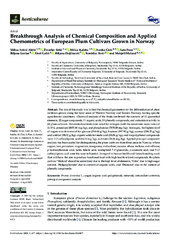Приказ основних података о документу
Breakthrough Analysis of Chemical Composition and Applied Chemometrics of European Plum Cultivars Grown in Norway
| dc.creator | Fotirić Akšić, Milica | |
| dc.creator | Tešić, Živoslav | |
| dc.creator | Kalaba, Milica | |
| dc.creator | Ćirić, Ivanka | |
| dc.creator | Pezo, Lato | |
| dc.creator | Lončar, Biljana | |
| dc.creator | Gašić, Uroš | |
| dc.creator | Dojčinović, Biljana | |
| dc.creator | Tosti, Tomislav | |
| dc.creator | Meland, Mekjell | |
| dc.date.accessioned | 2023-06-21T08:58:30Z | |
| dc.date.available | 2023-06-21T08:58:30Z | |
| dc.date.issued | 2023 | |
| dc.identifier.issn | 2311-7524 | |
| dc.identifier.uri | http://aspace.agrif.bg.ac.rs/handle/123456789/6340 | |
| dc.description.abstract | The aim of this study was to find the chemical parameters for the differentiation of plum cultivars grown along the fjord areas of Western Norway and Eastern Norway, having specific agroclimatic conditions. Chemical analysis of the fruits confirmed the contents of 13 quantified elements, 22 sugar compounds, 11 organic acids, 19 phenolic compounds, and antioxidant activity in 68 plum cultivars. Dominated contents were noted for nitrogen (with the maximum mean value of 3.11%), potassium (8055.80 mg/kg), and phosphorous (7878.88 mg/kg). Averagely, the highest level of sugars was determined for glucose (244.46 g/kg), fructose (197.92 g/kg), sucrose (208.25 g/kg), and sorbitol (98.02 g/kg), organic acids for malic acid (24.06 g/kg), and for polyphenol compounds were 5-O-caffeoylquinic acid (66.31 mg/kg), and rutin (58.06 mg/kg). Applied principal component analysis has been useful for distinguishing the plum cultivars from three areas in Norway where copper, iron, potassium, magnesium, manganese, and sodium; sucrose, ribose, maltose, and raffinose; p-hydroxybenzoic acid, rutin, ferulic acid, kaempferol 7-O-glucoside, p-coumaric acid, and 5-O-caffeoylquinic acid were the most influential. In regard to human health and future breeding work that will have the aim to produce functional food with high health-related compounds, the plum cultivar ‘Mallard’ should be underlined due to the high level of elements, ‘Valor’ due to high sugar content, ‘Helgøyplomme’ due to content of organic acids, and ‘Diamond’ due to the content of phenolic compounds. © 2023 by the authors. | |
| dc.language | English | |
| dc.relation | info:eu-repo/grantAgreement/MESTD/inst-2020/200116/RS// | |
| dc.relation | info:eu-repo/grantAgreement/MESTD/inst-2020/200168/RS// | |
| dc.relation | info:eu-repo/grantAgreement/MESTD/inst-2020/200288/RS// | |
| dc.relation | info:eu-repo/grantAgreement/MESTD/inst-2020/200051/RS// | |
| dc.relation | info:eu-repo/grantAgreement/MESTD/inst-2020/200134/RS// | |
| dc.relation | info:eu-repo/grantAgreement/MESTD/inst-2020/200007/RS// | |
| dc.relation | info:eu-repo/grantAgreement/MESTD/inst-2020/200026/RS// | |
| dc.rights | openAccess | |
| dc.rights.uri | https://creativecommons.org/licenses/by/4.0/ | |
| dc.source | Horticulturae | |
| dc.source | Horticulturae | |
| dc.subject | antioxidant activities | |
| dc.subject | minerals | |
| dc.subject | organic acid | |
| dc.subject | polyphenols | |
| dc.subject | principal component analysis | |
| dc.subject | Prunus domesticaL | |
| dc.subject | sugar | |
| dc.title | Breakthrough Analysis of Chemical Composition and Applied Chemometrics of European Plum Cultivars Grown in Norway | |
| dc.type | article | en |
| dc.rights.license | BY | |
| dc.citation.issue | 4 | |
| dc.citation.rank | M21~ | |
| dc.citation.volume | 9 | |
| dc.identifier.doi | 10.3390/horticulturae9040477 | |
| dc.identifier.fulltext | http://aspace.agrif.bg.ac.rs/bitstream/id/24551/Breakthrough_Analysis_of_pub_2023.pdf | |
| dc.type.version | publishedVersion |


